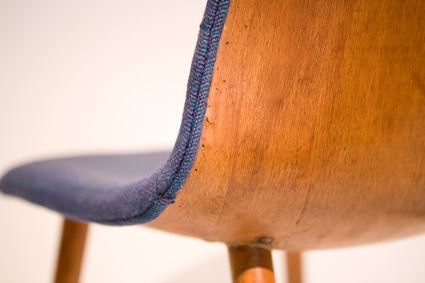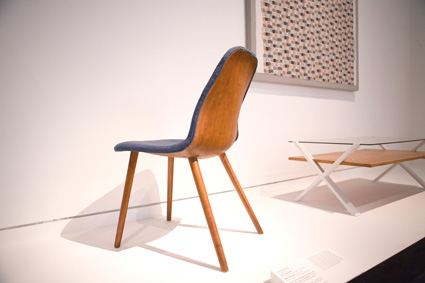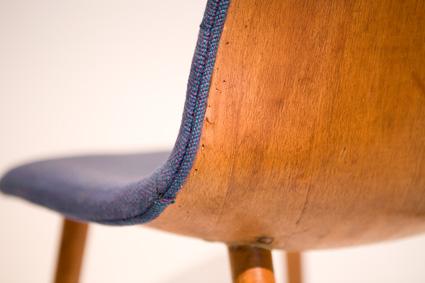
Charles Eames, Eero Saarinen, and Marli Ehrman (upholstery), "Chair from the Museum of Modern Art Organic Design Competition," 1940 (detail)
One time they were moving a Frank Lloyd Wright house in Mason City, Iowa, and I got to walk through the house as it rested on I-beams. I'd read a Wright biography but, standing in the living room and looking out the band of windows, I suddenly understood that, oh yeah, he made houses that people lived in. The Stockman House, as it's known, elaborated on a floorplan Wright had presented in a 1907 Ladies' Home Journal article called "A Fireproof House for $5,000."
A chair reminded me of that house the other day: a wooden side chair created by Charles Eames, Eero Saarinen, and Marli Ehrman and featured in the new exhibition "From the Spoon to the City": Design by Architects from LACMA's Collection. Plain in appearance ("the homeliest piece in the exhibition," assistant curator Bobbye Tigerman says cheerfully), the chair was part of Eames and Saarinen's first-place entry in MoMA's 1941 competition "Organic Design in Home Furnishings." As with Wright's floorplan, the idea of the competition was to encourage contemporary design at affordable prices.
"That was a major mission of modernism, going back as far as the Arts and Crafts period," Bobbye says. "The perennial struggle of the designer is whether to create for the masses, using less expensive materials and processes, or to design for the few and be able to incorporate expensive refinements. All designers must decide where they fall on that spectrum."

Charles Eames, Eero Saarinen, and Marli Ehrman (upholstery), "Chair from the Museum of Modern Art Organic Design Competition," 1940
It can be an inexact science, though. The Eames and Saarinen chair would have sold for a then relatively expensive $45 and was never put into production. That's because the chair, simple as it looks, represented a radical innovation in furniture making—the first time that thin layers of wood and glue were molded into three-dimensional shapes. The process wouldn't be practical for mass production until after World War II (during which Charles and Ray Eames learned a lot about molding plywood by making splints and airplane parts for the Navy).



